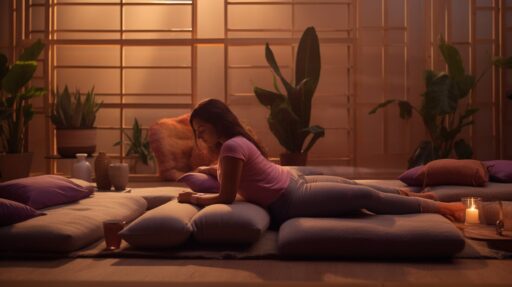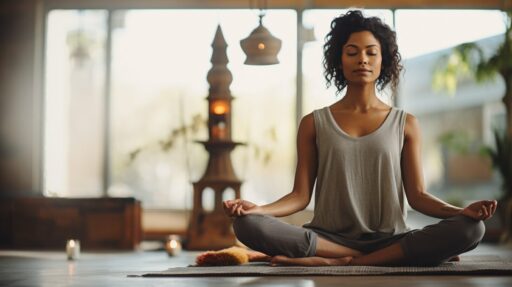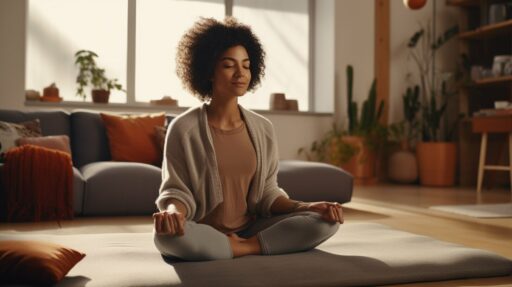Welcome to the world of restorative yoga, a practice that can help you find peace, relaxation, and rejuvenation. If you’re looking for a way to unwind, destress, and improve your overall well-being, restorative yoga poses may be just what you need. In this article, we will explore the benefits of restorative yoga, learn about different poses that promote relaxation, and discover how you can incorporate this gentle practice into your daily life.
Key Takeaways:
- Restorative yoga focuses on physical, mental, and emotional relaxation.
- It involves holding poses for extended periods of time, allowing for deep breathing and stillness.
- This gentle practice is suitable for all levels and promotes relaxation, stress relief, and improved flexibility.
- Restorative yoga poses include the Fish Pose, Child’s Pose, Corpse Pose, and Legs-up-the-wall Pose.
- Creating a quiet and clutter-free space in your home can support your restorative yoga practice.
What is Restorative Yoga?
Restorative yoga is a form of passive healing that activates the body’s parasympathetic nervous system, promoting rest, healing, and balance. It involves holding poses for long durations and uses props such as blocks, bolsters, and blankets for support. Restorative yoga focuses on deep relaxation and slow, deep breathing to elicit the relaxation response and reduce stress.
Unlike more dynamic styles of yoga, restorative yoga poses are gentle and calming, allowing the body to release tension and find a state of deep relaxation. These poses are designed to be held for extended periods, typically ranging from 5 to 20 minutes, allowing the body to fully surrender and reset.
During a restorative yoga session, the body is fully supported by props, which help to create a sense of safety and ease. The props not only provide physical support but also help to facilitate a deep sense of relaxation. By using props, the body can fully relax into the poses, releasing any unnecessary effort or strain.

The Benefits of Restorative Yoga
Restorative yoga offers numerous benefits for the mind, body, and spirit. The slow, gentle nature of this practice allows for deep relaxation and stress relief. It can help to reduce anxiety and improve overall well-being.
Restorative yoga also promotes improved flexibility and joint mobility. As the body is fully supported in each pose, the muscles can relax and release tension, allowing for a greater range of motion. This can be especially beneficial for individuals with tight muscles or limited mobility.
In addition, restorative yoga can help to improve sleep quality and reduce chronic pain. By engaging the parasympathetic nervous system, restorative yoga triggers the relaxation response in the body, which has a calming effect on the mind and can improve sleep patterns. The practice can also help to alleviate chronic pain by releasing tension and promoting greater body awareness.
Restorative Yoga Sequence
| Pose | Description |
|---|---|
| Supported Child’s Pose | Begin in a kneeling position with a bolster or folded blanket placed in front of you. Place your knees wide apart and slowly lower your torso onto the bolster, resting your forehead on the support. Relax your arms alongside the bolster and allow your entire body to melt into the pose. |
| Supported Reclining Bound Angle Pose | Position a bolster or two folded blankets lengthwise behind you. Sit on the edge of the bolster or blankets and recline back, bringing the soles of your feet together and allowing your knees to fall open to the sides. Support your knees with blocks or blankets, if needed, to ensure comfort. |
| Legs-up-the-Wall Pose | Sit sideways with one hip against the wall. Lie back and swing your legs up the wall, keeping your buttocks close to or touching the wall. Extend your arms alongside your body, palms facing up, and relax into the pose for several minutes. |
Remember to listen to your body and make any necessary adjustments to ensure comfort and support in each pose. As with any yoga practice, it’s important to work within your own limits and honor your body’s needs.
Benefits of Restorative Yoga
Restorative yoga offers numerous benefits for both the body and the mind. It is a gentle form of yoga that focuses on relaxation and stress relief, making it ideal for beginners or those looking for a more gentle practice. Practicing restorative yoga can help you find a sense of calm, improve your flexibility, and promote overall well-being.
One of the key benefits of restorative yoga is its ability to relax the mind and body. By holding gentle poses for extended periods of time, you allow your body to release tension and stress. This can help reduce anxiety and promote a sense of inner peace. Restorative yoga also encourages deep breathing, which can slow down your heart rate and activate your body’s relaxation response, further promoting relaxation and stress relief.
Restorative yoga is particularly beneficial for beginners, as the poses are gentle and accessible to people of all fitness levels. Props such as bolsters, blankets, and blocks are used to support your body in the poses, making it easier to relax and find comfort. This makes restorative yoga a great option for those recovering from injuries or dealing with chronic pain. It can help improve flexibility and range of motion, while also reducing pain and discomfort.
Overall, restorative yoga is a wonderful practice for promoting relaxation, stress relief, and overall well-being. Whether you’re a beginner or an experienced yogi, incorporating restorative poses into your practice can bring about profound benefits for both the body and the mind.

Table: Benefits of Restorative Yoga
| Physical Benefits | Mental Benefits | Emotional Benefits |
|---|---|---|
| Improves flexibility | Reduces anxiety and stress | Promotes emotional healing |
| Reduces chronic pain | Enhances mood | Fosters self-awareness |
| Enhances sleep quality | Improves mindfulness | |
| Reduces symptoms of depression |
Restorative Yoga Poses to Try
Restorative yoga poses are designed to promote deep relaxation, calm the mind, and release tension from the body. These poses focus on comfort, support, and stillness, allowing you to fully surrender and let go. Whether you’re looking to unwind after a long day or reduce stress and anxiety, incorporating these calming and relaxing yoga poses into your practice can bring a sense of peace and tranquility.
Gentle Poses for Relaxation
1. Child’s Pose (Balasana): This restorative pose gently stretches the hips, back, and shoulders, promoting deep relaxation and releasing tension. Start by kneeling on the floor, then lower your torso down between your thighs and extend your arms forward, resting your forehead on the mat or a prop for support.
2. Legs-up-the-wall Pose (Viparita Karani): This restorative inversion pose helps to improve circulation, relieve tired legs, and relax the nervous system. Sit with one side of your body against a wall, then swing your legs up and rest them against the wall while lying on your back. You can place a bolster or folded blanket under your hips for support.
Deeper Poses for Stress Relief
1. Fish Pose (Matsyasana): This restorative backbend stretches the chest and shoulders, relieving tension and promoting deep relaxation. Lie on your back with your knees bent, then lift your hips and slide your hands palms down under your buttocks, with the forearms and elbows tucked in close to your body. Lift your chest and head off the floor, relaxing the neck and resting the crown of your head on the mat or a prop.
2. Corpse Pose (Savasana): This ultimate relaxation pose allows your body to fully surrender and release tension. Lie on your back with your legs extended and your arms relaxed by your sides, palms facing up. Close your eyes and focus on your breath, allowing any stress or tension to melt away.

Remember to listen to your body and modify poses as needed to suit your level of comfort. Restorative yoga is a slow and gentle practice, so take your time to fully relax into each pose and breathe deeply. By incorporating these calming and relaxing yoga poses into your practice, you can experience the soothing benefits of restorative yoga and bring balance to your body and mind.
Finding a Qualified Restorative Yoga Instructor
When it comes to practicing restorative yoga, finding a qualified instructor is crucial for a safe and effective experience. A knowledgeable instructor can guide you through proper alignment, help you modify poses to suit your body’s needs, and provide a supportive and nurturing environment. Here are some key factors to consider when searching for a restorative yoga instructor:
- Experience and Certification: Look for instructors who have specific training and certification in restorative yoga. This ensures that they have undergone rigorous training and have a deep understanding of the practice.
- Teaching Style: Every instructor has a unique teaching style. Attend trial classes or workshops to get a sense of their teaching approach and see if it resonates with you. A good instructor should be able to create a safe and welcoming space for their students.
- Reputation and Reviews: Research the instructor’s reputation and read reviews from other students. Look for testimonials that highlight their expertise, professionalism, and ability to create a positive learning environment.
- Continuing Education: A dedicated instructor will continue to expand their knowledge and skills through ongoing education and training. Find out if the instructor participates in workshops, seminars, or advanced training to deepen their understanding of restorative yoga.
Remember, finding the right instructor is a personal journey. Trust your instincts and choose someone who makes you feel comfortable and supported. A qualified instructor will help you explore the restorative yoga asanas with confidence and guide you on your path towards relaxation and well-being.

Table: Comparing Restorative Yoga Instructors
| Instructor | Experience | Certifications | Teaching Style | Reviews |
|---|---|---|---|---|
| Emma Smith | 10+ years | RYT 500, Restorative Yoga Certified | Gentle and nurturing | “Emma creates a calming atmosphere and provides great modifications for all levels.” |
| Jonathan Davis | 5 years | RYT 200, Restorative Yoga Certified | Relaxing and meditative | “Jonathan’s classes are a perfect blend of relaxation and deep healing.” |
| Sarah Thompson | 3 years | RYT 200, Restorative Yoga Certified | Supportive and compassionate | “Sarah’s classes helped me find inner peace and reduce stress.” |
Table: Comparing restorative yoga instructors based on experience, certifications, teaching style, and reviews.
Establishing a Restorative Yoga Home Practice
Creating a space in your home for restorative yoga practice is essential. This dedicated space will allow you to fully immerse yourself in the practice and find tranquility amidst the busyness of everyday life. Choose a quiet area where you can create an atmosphere of relaxation and focus. Clear away any clutter and ensure the space is clean and inviting.
Investing in high-quality props is also important to support your restorative yoga practice. Consider purchasing a comfortable yoga mat, bolsters, blocks, blankets, and straps. These props will help you find proper alignment, provide support, and allow you to fully surrender into each pose. With the right props, you can create a safe and nurturing environment for your home practice.
Creating a Calming Ambience
To enhance the atmosphere of your restorative yoga practice, consider incorporating elements that promote serenity and relaxation. Soft lighting, such as candles or dimmed lamps, can create a cozy and soothing ambiance. You may also choose to play gentle instrumental music or nature sounds to further enhance the calming effect.
Establishing a consistent practice routine is also key to developing a home practice. Set aside dedicated time each day or week to engage in restorative yoga. Whether it’s early morning or before bedtime, find a time that works best for you and commit to it. Consistency will help you cultivate a sense of discipline and reap the benefits of regular practice.
Having a dedicated space for restorative yoga at home allows you to easily incorporate this peaceful practice into your daily routine. It creates a sense of sanctuary where you can nourish your mind, body, and soul.”
Finally, consider utilizing online platforms that offer a variety of restorative yoga classes to support your home practice. Websites like YogaGlo and Gaia Yoga provide a wide range of guided classes that you can access from the comfort of your home. These platforms offer convenience and flexibility, allowing you to tailor your practice to your specific needs and preferences.

| Benefits of Establishing a Restorative Yoga Home Practice | Guidelines for Creating a Restorative Yoga Space |
|---|---|
|
|
By establishing a restorative yoga home practice, you can access the healing benefits of this gentle practice whenever you need it. It allows you to cultivate a sense of self-care and self-awareness, promoting relaxation, stress relief, and overall well-being. Embrace the serenity of a dedicated space, invest in high-quality props, and create a consistent routine to fully immerse yourself in the transformative power of restorative yoga.
The Transformative Power of Restorative Yoga
Restorative yoga goes beyond physical relaxation and offers a multitude of benefits for your overall well-being. By integrating gentle postures, deep breathing, and mindfulness, this practice can transform your body, mind, and spirit. Let’s explore some of the remarkable benefits that restorative yoga provides:
Physical Benefits
- Increased flexibility: Restorative yoga poses gently stretch and elongate the muscles, enhancing your overall flexibility.
- Improved sleep quality: By promoting deep relaxation and reducing stress, restorative yoga can help improve the quality of your sleep.
- Pain reduction: Restorative poses can offer relief from chronic pain conditions by releasing tension and promoting healing.
- Enhanced digestion: The gentle movements and deep breathing in restorative yoga can stimulate digestion and improve gut health.
Mental and Emotional Benefits
- Reduced anxiety and stress: The slow, deliberate nature of restorative yoga helps calm the nervous system, reducing feelings of anxiety and stress.
- Mindfulness promotion: Restorative poses encourage present-moment awareness, allowing you to cultivate mindfulness and focus on the here and now.
- Improved mood: Restorative yoga can boost your mood and promote feelings of peace, relaxation, and well-being.
- Self-awareness and emotional healing: Through the practice of restorative yoga, you can develop a deeper understanding of your emotions and work towards emotional healing.
The transformative power of restorative yoga lies in its ability to nourish your body, calm your mind, and awaken your spirit. Incorporating this practice into your routine can lead to a greater sense of well-being and inner peace. Take a moment to prioritize your self-care and explore the remarkable benefits of restorative yoga today.

Table: Restorative Yoga Benefits
| Physical Benefits | Mental and Emotional Benefits |
|---|---|
| Increased flexibility | Reduced anxiety and stress |
| Improved sleep quality | Mindfulness promotion |
| Pain reduction | Improved mood |
| Enhanced digestion | Self-awareness and emotional healing |
The Spiritual Benefits of Restorative Yoga
Restorative yoga offers more than just physical and mental relaxation. It also provides numerous spiritual benefits that can enhance your overall well-being. Through the practice of restorative yoga, you can cultivate a deeper connection with yourself and experience profound inner transformation.
Enhanced Self-Awareness
Restorative yoga encourages you to slow down and turn your attention inward. As you hold each pose, you have the opportunity to observe your thoughts, emotions, and sensations without judgment. This heightened self-awareness allows you to gain insight into your patterns, triggers, and beliefs, facilitating personal growth and self-discovery.
Mental Clarity
By engaging in restorative yoga, you create space for mental clarity and stillness. The practice helps calm the mind and quiet the constant chatter, allowing you to focus on the present moment. With a clear and focused mind, you can develop a greater sense of clarity, enabling you to make informed decisions and cultivate a more balanced perspective on life.
“Restorative yoga provides a space for deep introspection, allowing individuals to connect with their inner selves on a profound level.”
Emotional Healing
Restorative yoga can be a powerful tool for emotional healing. The practice invites you to release any pent-up emotions, stress, or tension stored in the body. As you surrender to the support of props and embrace stillness, you create a safe space to process and heal emotional wounds. This can lead to a greater sense of emotional well-being and a more positive outlook on life.

Introduction to Meditation Practice
Restorative yoga serves as an introduction to meditation practice. Through the gentle and supported poses, you develop the ability to quiet the mind and focus your attention in the present moment. This meditative aspect of restorative yoga can deepen your mindfulness practice, allowing you to cultivate a sense of inner peace and greater connection to the present moment.
Incorporating restorative yoga into your self-care routine can have profound spiritual benefits. It offers an opportunity to explore your inner landscape, foster self-awareness, and cultivate a deep sense of inner peace and personal growth. Whether you are new to yoga or have an established practice, restorative yoga provides a nurturing space for your spiritual journey.
Restorative Yoga for Rejuvenation
Restorative yoga is a gentle and healing practice that promotes rejuvenation of the mind, body, and spirit. By incorporating restorative yoga into your wellness routine, you can experience deep relaxation, stress relief, and a renewed sense of vitality. Whether you choose to attend restorative yoga classes or practice at home, this transformative practice offers numerous benefits for your overall well-being.
Restorative yoga classes provide a nurturing and supportive environment where you can unwind and recharge. Guided by a qualified instructor, you will be guided through a series of restorative poses that are designed to promote relaxation and release tension. These poses are often supported by props such as bolsters, blankets, and blocks, allowing you to fully surrender into each posture. Through deep breathing and stillness, you can tap into the body’s natural healing abilities and cultivate a sense of inner calm.
For those who prefer to practice restorative yoga at home, there are a variety of resources available. Online platforms offer a wide range of restorative yoga classes that can be accessed from the comfort of your own space. These classes often include guided meditation or sound healing practices to enhance relaxation and rejuvenation. Creating a dedicated space in your home for restorative yoga practice can further enhance your experience. Choose a quiet area free from distractions, and invest in high-quality props to support your practice.
By incorporating restorative yoga into your routine, you can experience the rejuvenating benefits it offers. From stress reduction and improved sleep quality to enhanced flexibility and overall well-being, restorative yoga provides a gentle yet powerful way to restore balance in your life. So, why not try a restorative yoga class or create a home practice today? Give yourself the gift of rejuvenation and discover the transformative power of restorative yoga.
Table: Benefits of Restorative Yoga for Rejuvenation
| Benefits | Description |
|---|---|
| Stress Relief | Restorative yoga promotes relaxation and reduces stress, allowing you to unwind and find inner peace. |
| Improved Sleep Quality | By incorporating restorative yoga into your routine, you can improve the quality of your sleep and wake up feeling refreshed and rejuvenated. |
| Enhanced Flexibility | The gentle stretches and supported poses in restorative yoga help increase flexibility and release tension in the body. |
| Recovery and Healing | Restorative yoga promotes healing by activating the body’s natural relaxation response, allowing for physical and emotional recovery. |
| Overall Well-Being | By prioritizing self-care and incorporating restorative yoga into your routine, you can enhance your overall well-being and cultivate a sense of inner balance. |

Conclusion
Restorative yoga offers a wide range of options for those seeking relaxation, stress relief, and rejuvenation. Whether you prefer to practice at home or in a class setting, there are plenty of opportunities to explore this gentle and healing practice.
One way to deepen your understanding of restorative yoga is to attend workshops and classes dedicated to this specific style. These specialized sessions provide expert guidance and a supportive community, allowing you to fully immerse yourself in the practice and experience its transformative benefits.
The benefits of restorative yoga are numerous and encompass both physical and mental well-being. By incorporating restorative yoga into your routine, you can enjoy increased flexibility, reduced stress, improved sleep quality, and enhanced self-awareness. It is a practice that nurtures not only your body but also your mind and spirit.
So, whether you choose to explore restorative yoga options in your local community or online, you can begin reaping the benefits today. Embrace the opportunity to relax, heal, and find balance in your life through the transformative power of restorative yoga.
FAQ
What is restorative yoga?
Restorative yoga is a style of yoga that focuses on physical, mental, and emotional relaxation. It involves holding poses for extended periods of time, allowing for deep breathing and stillness.
What are the benefits of restorative yoga?
Restorative yoga offers numerous benefits, including relaxation of the mind and body, reduced stress and anxiety, improved mood, enhanced sleep quality, reduced chronic pain, improved well-being, and gentle on the body.
What are some popular restorative yoga poses?
Some popular restorative yoga poses include the Fish Pose, Child’s Pose, Corpse Pose, and Legs-up-the-wall Pose. These poses can help relieve tension, stretch the body, promote relaxation, and reduce stress.
How do I find a qualified restorative yoga instructor?
When looking for a restorative yoga instructor, it is important to check their credentials, experience, and teaching style. Look for instructors who are certified and have specific training in restorative yoga.
How can I establish a restorative yoga practice at home?
Creating a space in your home for restorative yoga practice is essential. Choose a quiet and clutter-free area where you can relax and focus. Invest in high-quality props like yoga mats, bolsters, and blankets to support your practice.
What are the spiritual benefits of restorative yoga?
Restorative yoga offers spiritual benefits, including enhanced self-awareness, mental clarity, emotional healing, and an introduction to meditation practice. The practice allows for deep introspection, promotes emotional release, and cultivates a sense of inner peace and personal growth.
Is restorative yoga suitable for all ages and fitness levels?
Yes, restorative yoga is a gentle and healing practice that can be practiced by people of all ages and fitness levels. It helps the body relax, heal, and regenerate, improving overall well-being.
What should I expect in a restorative yoga class?
Restorative yoga classes typically incorporate props, deep relaxation techniques, and guided meditation or sound healing for a transformative experience.
